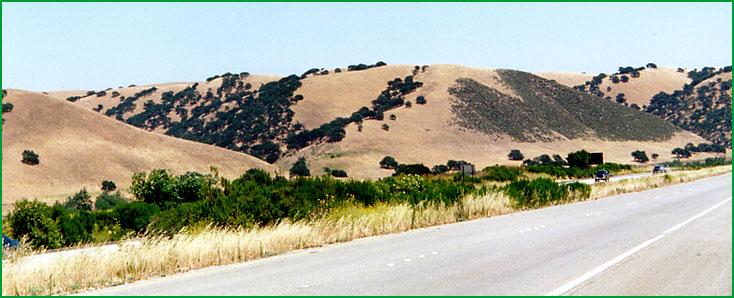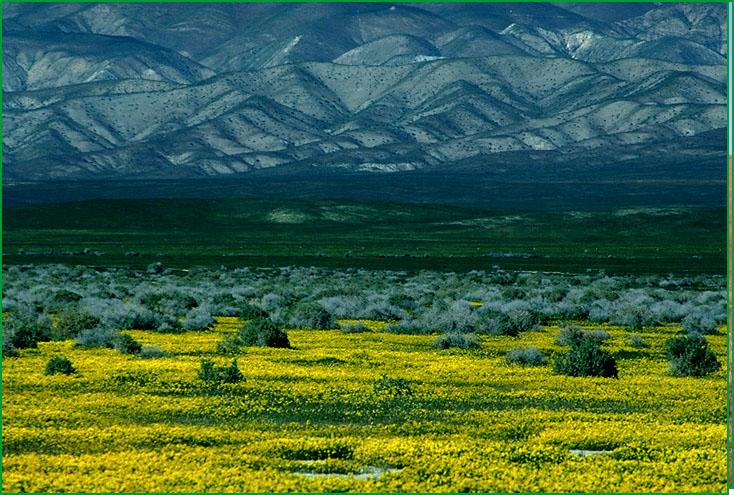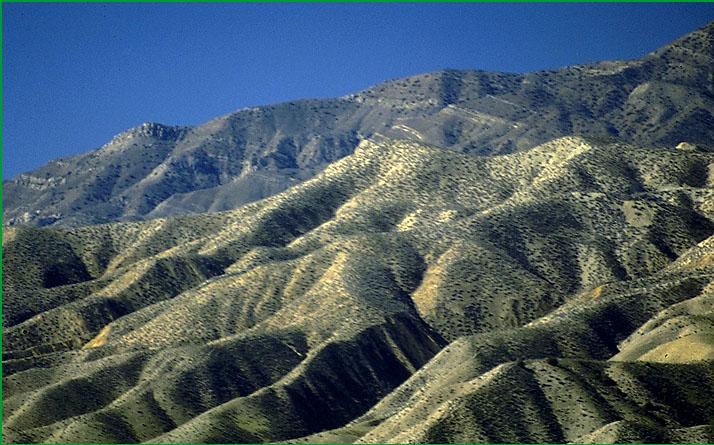 | Paso Robles Hills and Valleys- Carrizo Plain-Caliente Range - Cuyama Valley-Temblor Range |
Paso Robles Hills and Valleys-south of San Ardo Ś Scott Miles |
Carrizo Plain - Range (M262Ak) in background Ś James R. Nelson |
Caliente Range - Caliente Range area Ś James R. Nelson |
http://www.fs.fed.us/r5/projects/ecoregions/m262ah.htm
Subsection M262Ah
Paso Robles Hills and Valleys
This subsection is a dissected plain and low, moderately steep to steep hills around it. It is bounded by the Gabilan Range of the north, by the San Andreas fault and the Cholame Hills on the northeast, and by the Santa Lucia Range on the southwest. The climate is hot and subhumid. MLRA 17g.
Lithology and Stratigraphy. This subsection is dominated by Plio-Pleistocene nonmarine sediments. There are much smaller areas of Miocene and Pliocene marine sediments and some Quaternary alluvium.
Geomorphology. This subsection is dominated by a dissected plain of Plio-Pleistocene nonmarine sediments. It is surrounded by low, moderately steep to steep hills in Miocene and Pliocene marine sediments. There are narrow strips of recent alluvium and stream terraces along the Salinas River and its tributaries. The elevation range is from about 600 along the Salinas River up to about 1200 feet on the hills. Mass wasting and fluvial erosion and deposition are the dominant geomorphic processes.
Soils. The soils are mostly Calcic Haploxerolls, Typic Argixerolls, and Calcixerollic Xerochrepts. Typic Haploxerolls, Typic Xeropsamments, and Pachic Argixerolls predominate on hills above the Plio-Pleistocene plain. Soils on the stream terraces are Typic and Mollic Haploxeralfs and Typic Palexeralfs, and those on floodplains are Typic Xerofluvents and Cumulic Haploxerolls. Calcium carbonates accumulate in the subsoils. Soil temperature regimes are thermic, and soil moisture regimes are xeric.
Vegetation. The predominant natural plant communities are Blue oak series and Needlegrass grasslands. There is some Chamise series on shallow soils and Valley oak series on deep soils.
Characteristic series by lifeform include:
Grasslands: California annual grassland series, Purple needlegrass series.
Shrublands: Bigberry manzanita series, California sagebrush series, Chamise series, Chamise - bigberry manzanita series, Deer brush series, Scrub oak series, Wedgeleaf ceanothus series.
Forests and woodlands: Birchleaf mountain-mahogany series, Blue oak series, California sycamore series, Coast live oak series, Coulter pine series, Coulter pine - canyon live oak series, Foothill pine series, Interior live oak series, Valley oak series.
Climate. The mean annual precipitation is about 12 to 18 inches. All of the precipitation is rain. Mean annual temperature is about 55░ to 60░ F. The mean freeze-free period is about 225 to 250 days.
Surface Water. Runoff is rapid and all but the larger streams are dry through most of the summer. Natural lakes are absent.
Subsection M262Ai
Carrizo Plain
This subsection is the floor of a broad valley that is aligned toward the northwest. It is bounded on the northeast by the Temblor Range and on the southwest by the Caliente Range. The San Andreas fault runs along the northeast edge of the Valley. The climate is hot and subhumid to arid. MLRA 17f.
Lithology and Stratigraphy. This subsection is dominated by Quaternary alluvium. There are large areas of Plio-Pleistocene nonmarine sediments that are more concentrated in the north end of the valley and small areas of Oligocene, Miocene, and Pliocene marine and nonmarine sediments along the southwest margin of the subsection. Lake sediments have been deposited and are still accumulating in the center of the valley.
Geomorphology. This subsection consists of nearly level to very gently sloping alluvial plain with low hills on the margins. The alluvial plain is dominated by recent fans and basin-fill. The basin-fill includes lacustrine deposits. There is little dissection of the Plio-Pleistocene depositional surface, and even less on the recent alluvial fans. The elevation range is from slightly less than 2000 feet in the center of the valley up to about 2400 feet on the hills. Fluvial erosion and deposition are the main geomorphic processes. Some of the sedimentation is lacustrine on basin-fill.
Soils. The soils are mostly Mollic Haploxeralfs and Aridic Haploxerolls on alluvial fans and Typic Natrixeralfs and Xeric Torriorthents around playas near the center of the basin-fill. Xeric Torriorthents are dominant and Calcic Haploxerolls are common on Plio-Pleistocene nonmarine and older sediments. The soils are well drained, except those around playas near the center of the valley. Carbonates accumulate in the subsoils, and more soluble salts accumulate in soils near the center of the basin-fill. Soil temperature regimes are thermic. Soil moisture regimes are aridic and xeric.
Vegetation. The predominant natural plant communities are California annual grassland series, Needlegrass grasslands, Salt grass series, and Emergent aquatic communities.
Characteristic series by lifeform include:
Grasslands: California annual grassland series, purple needlegrass series, Saltgrass series.
Shrublands: Allscale series, Arrow weed series, Bladderpod - California ephedra - narrowleaf goldenbush series, Fourwing saltbrush series, Shadescale series, Spinescale series.
Climate. The mean annual precipitation is about 10 to 16 inches, all of which is rain. Mean annual temperature is about 55░ to 58░ F. The mean freeze-free period is about 225 to 250 days.
Surface Water. Runoff from hills is rapid. Water from the hills collects on the basin floor to form ephemeral lakes and ponds. Although there is no surface drainage from the center of the basin, it is open on the northwest end and drainage from there and from the western edge of the plain is to the Salinas River.
Subsection M262Aj
Caliente Range - Cuyama Valley
This subsection comprises the mountains of the Caliente Range and hills and an alluvial plain along the Cuyama River. It is between the Carrizo Plain and the Sierra Madre Mountains. The climate is hot and subhumid to arid. MLRAs 15f, 15g, 17f, and 17g.
Lithology and Stratigraphy. This subsection is dominated by clastic sedimentary rocks and weakly consolidated deposits. There are large proportions of upper Cretaceous sedimentary rocks, Miocene marine sediments, Pliocene and Pleistocene nonmarine sediments, and Quaternary alluvium.
Geomorphology. This subsection contains steep mountains with narrow canyons in the Caliente Range and low hills, alluvial fans, pediments, and terraces along the Cuyama River. The mountains are oriented from northwest to southeast, curving around toward the east-southeast at the southeastern end where the mountains of this subsection bend around on the southwest side of a curve in the San Andreas fault. The Cuyama River runs lengthwise through the subsection, along the southwest side of the Caliente Range. The alluvial plain of the Cuyama River is broad in the southeastern part of the subsection, where it is about 5 or 6 miles across, with a fault on the north-northeast side and Tertiary sediments and dissected Quaternary alluvial fans on the south-southwest side of the valley. The elevation range is from just under 2000 feet up to about 5000 feet. It is about 2000 to 2600 feet in Cuyama Valley. Mass wasting and fluvial erosion are the main geomorphic processes.
Soils. On upper Cretaceous sedimentary rocks, the soils are mostly rocky Lithic Xerorthents and Mollic Haploxeralfs. On Miocene marine sediments, associated with badlands, the soils are mostly shallow Typic Xerorthents, Pachic Haploxerolls, and Mollic Haploxeralfs. On Pliocene and Pleistocene nonmarine sediments, the soils are mostly shallow Xeric Torriorthents, Typic Xerorthents, and Typic Haploxeralfs. On Quaternary alluvial fans, the soils are mostly Xerorthents, Typic and Mollic Haploxeralfs, and Pachic Argixerolls. On recent alluvium, they are Typic Xerofluvents and Xerorthents and Typic Salorthids. The soils are well drained, but the Salorthids are exceptions. Calcium carbonates accumulate in the subsoils, and more soluble salts accumulate in some soils in Quaternary alluvium. Soil temperature regimes are mostly thermic, with some mesic on north-facing slopes at higher elevations. Soil moisture regimes are mostly xeric, but aridic in much of the Cuyama Valley.
Vegetation. The predominant natural plant communities are Blue oak series, Needlegrass grasslands, Chamise series on shallow soils, and California annual grassland series around Cuyama Valley. Around Cuyama Valley, Allscale series is present on salty soils and Iodine bush series on very salty soils. California juniper series is present on the south side of Cuyama Valley.
Characteristic series by lifeform include:
Grasslands: California annual grassland series, purple needlegrass series, Saltgrass series.
Shrublands: Allscale series, Arrow weed series, Bladderpod - California ephedra - narrowleaf goldenbush series, Chamise series, Cupleaf ceanothus - fremontia - oak series, Fourwing saltbrush series, Iodine bush series, Shadescale series, Spinescale series.
Forests and woodlands: Blue oak series. California juniper series, Mesquite series.
Climate. The mean annual precipitation is from 6 to 10 inches in Cuyama Valley up to about 15 inches in the mountains. The precipitation is mostly rain, with a little snow at higher elevations. Mean annual temperature is about 50░ to 60░ F. The mean freeze-free period is about 175 to 225 days.
Surface Water. Runoff from the mountains and hills is rapid, but drainage is slow from some of the soils in the Cuyama Valley. The Cuyama River runs northwestward through this subsection then, after leaving the subsection, southwestward across the Coast Ranges toward the Pacific Ocean. All streams other than the Cuyama River and its larger tributaries are dry through the summer. There are no natural lakes in the subsection.
Subsection M262Ak
Temblor Range
This subsection comprises the mountain range between the San Joaquin Valley and the Carrizo Plains. The San Andreas fault is along the southwestern edge of the subsection. The climate is hot and subhumid to arid. MLRA15f.
Lithology and Stratigraphy. This subsection is dominated by lower Cretaceous marine sedimentary rocks, Eocene marine sediments, and mostly by Miocene marine sediments. Plio-Pleistocene nonmarine sediments are extensive in the northwest part of the subsection.
Geomorphology. This subsection is a long narrow range of steep mountains aligned northwest, but it includes moderately steep hills around the margin of the Temblor Range. There are few valleys, or segments of valleys, wide enough to have appreciable areas of alluvium. The elevation range is from about 1200 feet up to about 4000 feet. Mass wasting and fluvial erosion are the main geomorphic processes. Creep is important on moderately steep Vertisols.
Soils. The soils are mostly Lithic Xerorthents, Typic Xerorthents, and Entic Chromoxererts. On Miocene sediments, in addition to the Xerorthents, shallow Xeric Torriorthents and Pachic Haploxerolls are common. Carbonates accumulate in subsoils. Soil temperature regimes are thermic. Soil moisture regimes mostly xeric, but aridic on shallow soils at lower elevations.
Vegetation. The predominant natural plant communities are Blue oak series, California juniper series, Needlegrass grasslands, Chamise series, and California annual grassland series.
Characteristic series by lifeform include:
Grasslands: California annual grassland series, purple needlegrass series, Saltgrass series.
Shrublands: Allscale series, Arrow weed series, Bladderpod - California ephedra - narrowleaf goldenbush series, Chamise series, Cupleaf ceanothus - fremontia - oak series, Fourwing saltbrush series, Shadescale series, Spinescale series.
Forests and woodlands: Blue oak series. California juniper series.
Climate. The mean annual precipitation is from 9 to 15 inches. The precipitation is mostly rain. Mean annual temperature is about 55░ to 65░ F. The mean freeze-free period is about 200 to 275 days.
Surface Water. Runoff from the mountains and hills is rapid, and all of the streams are dry through the summer. There are no natural lakes in the subsection.


